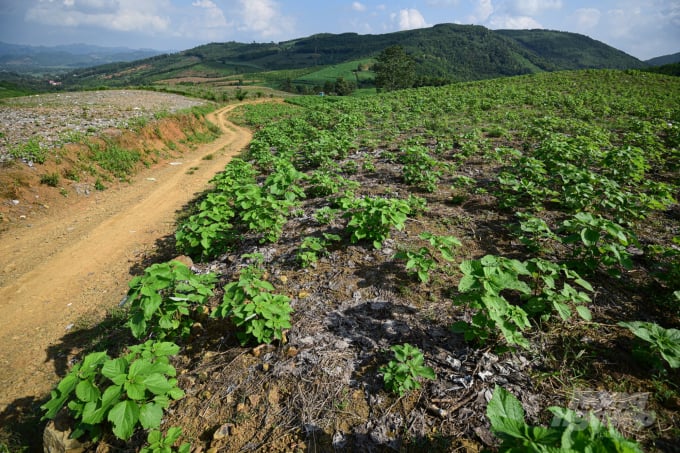November 25, 2025 | 04:35 GMT +7
November 25, 2025 | 04:35 GMT +7
Hotline: 0913.378.918
November 25, 2025 | 04:35 GMT +7
Hotline: 0913.378.918

Ramie farming provides sustainable livelihoods for farmers in Cam Tu commune, Cam Thuy district (Thanh Hoa province). Photo: Tung Dinh.
Ramie is considered as a high-value crop in Cam Tu commune, Cam Thuy district (Thanh Hoa province) that provides higher net returns per hectare to local farmers compared to other traditional crops like cassava or sugarcane.
Ramie is not only easy to grow but all parts of the plant can also be utilized. Particularly leaves and stems can be turned into organic fertilizer to enrich the soils.
With 19 hectares of ramie plant cultivation, Pham Thi Thanh , a farmer in Cam Tu commune, Cam Thuy district is one of the partners supplying raw materials to An Phuoc Ramie Fiber Factory - Viramie- the first factory producing fiber from ramie in Vietnam
"I've never thought that ramie can create such a good income. I feel like a dream," Thanh said while harvesting ramie on the hill.
Thanh's family previously grew sugarcanes and cassavas to supply materials to the processing plants nearby but economic efficiency was not as high as expected. Since 2018 her family has switched to ramie plants and seen rapid and stable growth in income.
"In 2018 I started to grow ramie plants on 1 hectare of my land then I increased the area to 7.2 hectares in 2020 and continued to expand to 11 hectares by early 2021. Now, I have 19 hectares of ramie plants," Thanh said and adding that all ramie plants are cultivated on her family's land.

Phan Thi Thanh's family grows ramie plants on a 19-hectare farm in Cam Tu commue, Cam Thuy district (Thanh Hoa). Photo: Tung Dinh.
Thanh said: "You don't need to prepare soil for planting ramie plants. You don't have to remove weeds. The plants grow back after being cut. Importantly, you have to know when harvest time is and how to dry the cortex to prevent molds."
Talking about income, Thanh said her family can earn VND15 -20 million at maximum in each harvest season after deducting all costs. On average, one hectare of ramie plant cultivation can generate VND100 million per year for Thanh's family after paying off all expenses.
Apart from bringing economic benefits, ramie plants also help restore the soil. Currently, after harvesting stems and tripping the cortex, the rest of the ramie cuttings is chopped into small pieces as organic materials and evenly spread on the field.
Thanks to high protein content, ramie stems and leaves quickly loosen and nourish the soil.
Scientific studies showed that ramie leaves contains 78.8-82.4% of organic material content while that content in ramie stems and roots is higher than in the leaves.
Besides, raw proteins in ramie leaves are from 21,85 % to 22.91% while the content in stems and roots is from 8.2%-11.26% and from 5.84%-9.01% respectively. Therefore, apart from using ramie leaves and stems as organic fertilizer, these parts of ramie plant can be utilized as alternative sources of protein for feed of livestock.

Ramie leaves and stems can be utilized to enrich the soil. Photo: Tung Dinh.
In addition to protein, ramie leaves also contain 4.4% to 6.05% of fat. Among the parts of ramie plant, stem has the highest fat content.
Chemical composition analysis affirmed that ramie silage can serves as high-energy forage for ruminants.
One time of growing, ten years of harvesting
According to technicians of An Phuoc Ramie Fiber Factory - Viramie, ramie can be harvested around 75 days after planting. Then the plant can be harvested once every 45 - 55 days. Just with one time of planting AP1 ramie, farmers can harvest for 10 consecutive years. After each harvest season, the mother plants will grow new stems and leaves since the cutting. After 10 years, ramie roots can be used for medicinal purposes, especially good for pregnant women.
Translated by Mai Tham

(VAN) The information was shared at the seminar 'Urban Agriculture - Solutions for Developing Green Spaces,' organized by the Kinh te & Do thi Newspaper and the Biotechnology Center of Ho Chi Minh City.
/2025/11/19/4141-2-132831_216.jpg)
(VAN) One of Japfa's outstanding solutions is implementing digital transformation and artificial intelligence (AI) to optimize operations, enhance productivity, and advance sustainable development.
/2025/11/19/4847-1-093540_448.jpg)
(VAN) The Gia Lai Provincial People’s Committee had a working session with the delegation of the U.S. Department of Agriculture, the State of Idaho, and representatives of the State's leading enterprises.

(VAN) Ca Mau has a sufficient foundation to become a strong regional aquaculture center, where production integrates the economy, the environment, and the lives of the people.

(VAN) SEIKI Group envisions itself as a pioneer in the ‘dual transformation’ of digital technology and green industry, standing alongside the Government and Vietnamese businesses in their pursuit of sustainable development.

(VAN) The VNGEONET network affirms Viet Nam's progress in mastering digital space, providing a precise positioning data platform to serve socioeconomic development.
/2025/11/14/3247-1-184556_35.jpg)
(VAN) Thai Nguyen is methodically implementing digital transformation in the livestock sector, laying the foundation for a modern, transparent, and sustainable agriculture.